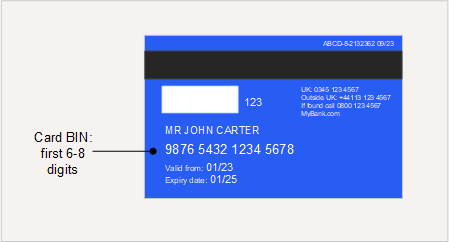11 Generated Card Elements
This section provides more information on how some card elements such as the PAN and Expiry Date, are generated.
11.1 Generating the PAN
The Primary Account Number (PAN) is the long number (typically 16-19 digits) printed or embossed on the card. It consists of the following components:
-
Banking Identification Number (BIN) - this is the first 6-8 digits of the PAN and is provided by your issuer, for use with cards in your programme. It identifies the card scheme (payment network) and issuer. The same BIN will appear on all cards, unless your programme supports multiple BIN ranges.
-
Unique account number - the remaining 8 digits are generated by Thredd when PAN stock generation is requested, and reflect the unique account associated with the card1
See the example below.

Thredd creates PAN stock in a batch process. Active products usually have auto-PAN stock generation enabled. PAN stock will be generated when it falls beneath a threshold, which is set at a product level. The PAN stock is linked to a card product in your card programme.
When the card record is created, Thredd assigns a PAN from the stock of available PANs.
11.2 Calculating the Expiry Date
There are two types of expiry dates that can be set up in our system:
-
The expiry date to be printed on the card
-
An internal system expiry date, which relates to how long the card record remains valid for after it is activated.
Printed Expiry Date
You can define at a Thredd scheme level for your programme the Card Validity Period, which is the period over which the card is valid.
Thredd uses the card validity period to calculate the card expiry date expiry date that will be printed on your physical cards.
For example:
-
Card Validity Period (in months) = 24 months (two years)
-
Date of card create request: 25/01/2023
-
Expiry date printed on card: 01/2025
If you want to set a specific expiry date to appear on the card which differs from the default expiry date, you can specify this date at the time when submitting your Create Card request. (This date can be up to 8 years in the future, but it cannot exceed the card validity period). See Creating Cards.
Most cards have a default expiry date of 3-5 years, depending on the issuer (BIN sponsor), but this can be set to your required length (e.g., 12 months or 5 years).
You can amend the expiry date of the card to any date within the validity period using Thredd Web Services API or the Cards API2. For details, see the Web Services Guide > Card Extend Expiry or Cards API Website.
Internal Expiry Date
This date is defined at a Product level and indicates how many days the card is valid for, from card Activation.
If you want to set a specific internal expiry date which differs from the default printed expiry date, you can specify this date when submitting a Card Activate request. See Managing Cards.
This option cannot be used to extend the expiry date past the expiry date printed on the card.
For example:
-
Card Validity Period (in months): 24 months (two years)
-
Internal Validity (in days): 365 days (1 year) after activation
Examples of usage scenarios for the internal expiry date:
-
You offer gift cards - with a maximum card validity period of 3 years (no expiry date is printed on the card). These may sit on a shelf in a store for a while before they are ordered. Once the card is activated, the card is valid for use within a year. If required, after the year, you can use the Extend Expiry Date web service or the Cards API to extend the expiry date for another period.
-
You offer customers a virtual card, which can be used until their physical card arrives and is activated. The virtual card is activated for immediate use, and expires after 21 days.